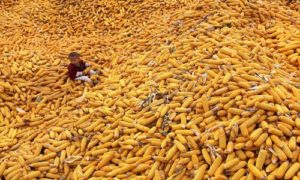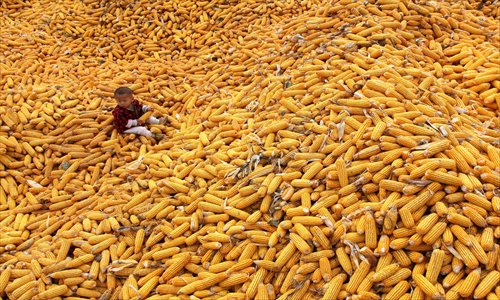Trade is one of the main trademarks of the globalization process. Nowadays, most countries exchange products and services regularly and use local comparative advantages to specialize in specific trade sectors and/or commodities. Food and agricultural products are important components of this process. Within countries, rapid urbanization has increased the demand for food.  Simultaneously, the number of people working in the agricultural sector and living in rural areas has decreased substantially. While some food staples are imported, others are still produced locally but must travel from rural areas to urban centers and big cities to meet the demand.
Simultaneously, the number of people working in the agricultural sector and living in rural areas has decreased substantially. While some food staples are imported, others are still produced locally but must travel from rural areas to urban centers and big cities to meet the demand.
Food products are thus in perpetual motion, moving from their place of birth as soon as possible towards a wide variety of geographic locations, ranging from a short distance away to the other side of the globe where they meet their final fate. Millions of food products generated and distributed daily by millions of suppliers located in thousands of locations create a complex global network that cannot be easily placed under one umbrella.
The Problem
Tracking a particular product in such a complex network can prove to be a daunting task. Two core issues must be considered here: 1. Provenance: where is the product (really) coming from? And 2. Traceability: How did the product get here? Knowing the full travel history of the product becomes possible in this fashion. Governments, vendors and consumers can be sure the food staple is indeed the original one and has not been modified or adulterated during migration before it reaches our dining tables.
While provenance and traceability help address most of the gaps in food safety, another dimension demands attention. Most countries have set standards when it comes to the particular nutritional content of most foods. Final vendors and consumers learn about this content via labels stamped on some foods – not the case for fresh fruits and vegetables, for example. But there is no way they can corroborate such printed claims directly.
Recent advances in spectroscopy and magnetic resonance, accompanied by the development of simple but smart hand-held scanning devices, have now made this possible. Using these new technologies, checking the actual chemical and molecular components of food products (and others) is now a reality. In this way, importers, vendors and consumers can verify the actual nutritional content of a particular food staple, in addition to learning if it has been adulterated before reaching their hands. And the technology can be applied to most food products regardless of them having nutritional labels attached to them.
Current Solutions
Supply chains have certainly not been exempt from technological innovation. On the contrary, from a business and investment perspective, this is perhaps one of the areas where innovation spearheaded by large technology corporations has taken place thanks to the advents of the Internet and other networking technologies. This is in response to the fact that most business supply chains are now globalized, bringing together suppliers and inputs from many geographies.
The deployment of technology on this front has been focused on using relational databases to keep track of the supply chain and its overall integration. Provenance and traceability are also featured and constitute one of the core goals of the exercise. While database storage is centralized in one location, access can be decentralized as users in the supply chain are in different places and time zones. Databases have a sophisticated system of access rights used to assign specific access levels to other users depending on their function, a feature that facilitates the above.
However, in most quarters, supply chains are considered confidential or proprietary information that cannot be shared widely. As a result, the public and the consumer of the products in question are not granted access to the platform’s data. The same goes for other users who need to be involved to ensure provenance and traceability and are not directly part of the supply chain. The reliability of the information recorded in the database can also prove and verify its authenticity is virtually impossible. Bad actors can indeed with access to the data and easily alter the information stored. Finally, multiple databases track different supply chains, which implies that multiple ledgers of information coexist but do not necessarily talk to each other.
Blockchains in action
Using food spectrometry can enhance blockchain’s potential to support both provenance and traceability of the food supply. The former is still taking baby steps. Current solutions are still based on traditional database systems – although artificial intelligence and mobile apps are commonly used. The core idea is to generate hashes from the spectrum captured from each food staple, store them on the blockchain and use it to verify both its content and life-cycle.
Deploying blockchains in the sector does not necessarily mean that existing platforms must be replaced or eliminated. Blockchains are not fully-fledged databases and consequently are less than ideal for storing massive amounts of data. But blockchains can talk to existing databases and use hashes to established such communication in a secure and immutable fashion.
Cheers, Raúl
Selected References
Bázár, Gy., Kovács, Z., Pintér, Zs., Darvish, B., Hoffmann, I. (2016). Testing the ability of a handheld food scanner to predict primary nutrients in model mixtures. http://physics2.bc.szie.hu/biosysfoodeng/cdrom/pdf/E105.pdf
CBInsights. (2018, January 24). How Blockchain Could Transform Food Safety. Retrieved from https://www.cbinsights.com/research/blockchain-grocery-supply-chain/
Hoffmann, I., Bazar, G. (2017): Future is here: your pocket laboratory that can give information about your food. http://rmagazine.com/future-is-here-your-pocket-laboratory-that-can-give-information-about-your-food/
Hornak, J. P. (2017). The Basics of NMR. http://www.cis.rit.edu/htbooks/nmr/inside.htm
Prindle, D. (2014, April 30). This pocket-sized molecular spectrometer tells you the chemical makeup of foods. Digital Trends. https://www.digitaltrends.com/cool-tech/pocket-sized-molecular-spectrometer-tells-chemical-makeup-foods/
Project Provenance. (2015, November 21). Blockchain: The solution for supply chain transparency. White Paper. https://www.provenance.org/whitepaper

